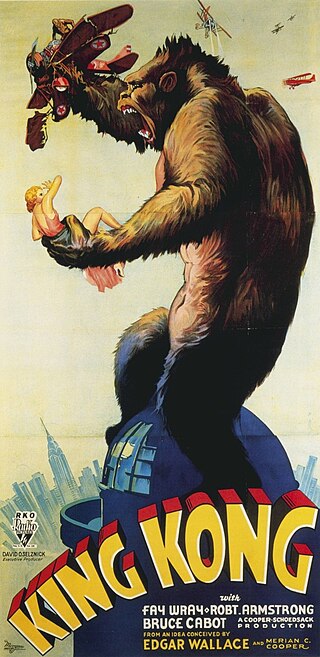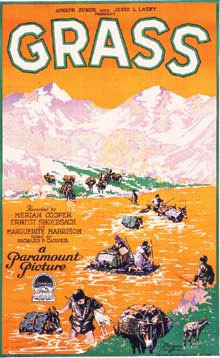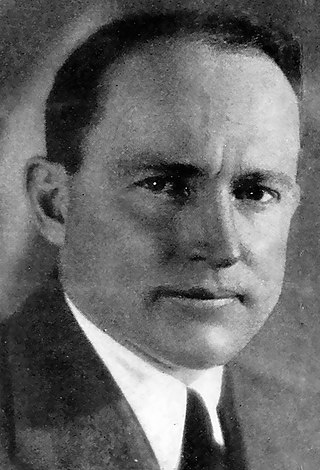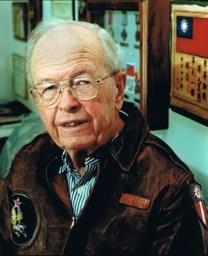Related Research Articles

Charles Martin Jones was an American animator, painter, voice actor and filmmaker, best known for his work with Warner Bros. Cartoons on the Looney Tunes and Merrie Melodies series of shorts. He wrote, produced, and/or directed many classic animated cartoon shorts starring Bugs Bunny, Daffy Duck, Wile E. Coyote and the Road Runner, Pepé Le Pew, Marvin the Martian, and Porky Pig, among others.

King Kong is a 1933 American pre-Code adventure romance monster film directed and produced by Merian C. Cooper and Ernest B. Schoedsack, with special effects by Willis H. O'Brien and music by Max Steiner. Produced and distributed by RKO Radio Pictures, it is the first film in the King Kong franchise. The film stars Fay Wray, Robert Armstrong, and Bruce Cabot. The film follows a giant ape dubbed Kong who is offered a beautiful young woman as a sacrifice.

Willis Harold O'Brien, known as Obie O'Brien, was an American motion picture special effects and stop-motion animation pioneer, who according to ASIFA-Hollywood "was responsible for some of the best-known images in cinema history," and is best remembered for his work on The Lost World (1925), King Kong (1933), The Last Days of Pompeii (1935) and Mighty Joe Young (1949), for which he won the 1950 Academy Award for Best Visual Effects.

Grass: A Nation's Battle for Life is a 1925 documentary film that follows a branch of the Bakhtiari tribe of Lurs in Persia as they and their herds make their seasonal journey to better pastures. It is considered one of the earliest ethnographic documentary films. In 1997, Grass was selected for preservation in the United States National Film Registry by the Library of Congress as being "culturally, historically, or aesthetically significant."

The golden age of American animation was a period in the history of U.S. animation that began with the popularization of sound synchronized cartoons in 1928 and gradually ended in the 1960s when theatrical animated shorts started to lose popularity to the newer medium of television. Animated media from after the golden age, especially on television, were produced on cheaper budgets and with more limited techniques between the late 1950s and 1980s.
Animation in the United States in the television era was a period in the history of American animation that gradually started in the late 1950s with the decline of theatrical animated shorts and popularization of television animation, reached its peak during the 1970s, and ended around the late 1980s. This era is characterized by low budgets, limited animation, an emphasis on television over the theater, and the general perception of cartoons being primarily for children.
The history of animation, the method for creating moving pictures from still images, has an early history and a modern history that began with the advent of celluloid film in 1888. Between 1895 and 1920, during the rise of the cinematic industry, several different animation techniques were developed or re-invented, including stop-motion with objects, puppets, clay or cutouts, and drawn or painted animation. Hand-drawn animation, which mostly consisted of a succession of still images painted on cels, was the dominant technique of the 20th century and became known as traditional animation.

Merian Caldwell Cooper was an American filmmaker, actor, and producer, as well as a former aviator who served as an officer in the United States Army Air Service and Polish Air Force. In film, his most famous work was the 1933 movie King Kong, and he is credited as co-inventor of the Cinerama film projection process. He was awarded an honorary Oscar for lifetime achievement in 1952 and received a star on the Hollywood Walk of Fame in 1960. Before entering the movie business, Cooper had a distinguished career as the founder of the Kościuszko Squadron during the Polish–Soviet War and was a Soviet prisoner of war for a time. He got his start in film as part of the Explorers Club, traveling the world and documenting adventures. He was a member of the board of directors of Pan American Airways, but his love of film took priority. During his film career, he worked for companies such as Pioneer Pictures, RKO Pictures, and Metro-Goldwyn-Mayer. In 1925, he and Ernest B. Schoedsack went to Iran and made Grass: A Nation's Battle for Life, a documentary about the Bakhtiari people.

Rankin/Bass Animated Entertainment was an American production company located in New York City. It was known for its seasonal television specials, usually done in stop motion animation. Rankin/Bass's stop-motion productions are recognizable by their visual style of doll-like characters with spheroid body parts and ubiquitous powdery snow using an animation technique called Animagic.

The Mighty Kong is a 1998 American animated monster musical film. It is an adaptation of the classic King Kong story, produced by Lana Productions and is the seventh entry in the King Kong franchise. Jodi Benson and Dudley Moore headed its cast of voice actors. The film was animated overseas by the South Korean animation studios including Hahn Shin Corporation, and by Jade Animation in Hong Kong. It features original songs by the Sherman Brothers. The film was initially given a limited theatrical release before being released on VHS on June 16, 1998 by Warner Home Video as a part of their 75th Anniversary promotion. It was released on DVD by Tri-Coast Entertainment in 2019 as a Manufacture-on-Demand (MOD) release that is only available through online stores. The film is currently available on multiple streaming platforms such as Tubi and Vimeo.

King Kong, also referred to simply as Kong, is a fictional giant monster, or kaiju, resembling a gorilla, who has appeared in various media since 1933. Kong has been dubbed the King of the Beasts, and over time, it would also be bestowed the title of the Eighth Wonder of the World, a widely recognized expression within the franchise. His first appearance was in the novelization of the 1933 film King Kong from RKO Pictures, with the film premiering a little over two months later.

Mighty Joe Young is a 1949 American black and white fantasy film distributed by RKO Radio Pictures and produced by the same creative team responsible for King Kong (1933). The film was produced by Merian C. Cooper, directed by Ernest B. Schoedsack, and written by Ruth Rose. It stars Robert Armstrong, Terry Moore, and Ben Johnson in his first credited screen role. Animation effects were handled by Willis O'Brien, Ray Harryhausen, Pete Peterson, and Marcel Delgado. It was released on July 13, 1949, and did not produce profit in the box office though reviews were generally positive. In 1950 the film won an Academy Award for special effects.
Chinese animation refers to animation made in China. In Chinese, donghua describes all animated works, regardless of style or origin. However, outside of China and in English, donghua is colloquial for Chinese animation and refers specifically to animation produced in China.

Ernest Beaumont Schoedsack was an American motion picture cinematographer, producer, and director. Schoedsack worked as a cameraman in World War I, where he served in the U.S. Army Signal Corps. At the conclusion of the war, he stayed in Europe to further his career. He worked on several films with Merian C. Cooper including King Kong, Chang: A Drama of the Wilderness, and The Most Dangerous Game. He also collaborated with screenwriter and actress Ruth Rose, whom he later married. Schoedsack died on December 23, 1979, at age 86.

King Kong, commonly referred to as The King Kong Show, is an animated television series produced by Videocraft International and Toei Animation. ABC ran the series in the United States on Saturday mornings between September 10, 1966, and August 31, 1969. It is the first anime-based series produced in Japan for an American company.

Gulliver's Travels is a 1939 American animated musical fantasy film produced by Max Fleischer and directed by Dave Fleischer for Fleischer Studios. Released to cinemas in the United States on December 22, 1939, by Paramount Pictures, the story is a very loose adaptation of Jonathan Swift's 1726 novel of the same name, specifically only the first part of four, which tells the story of Lilliput and Blefuscu, and centers around an explorer who helps a small kingdom who declared war after an argument over a wedding song. The film was Fleischer Studios' first feature-length animated film, as well as the second animated feature film produced by an American studio after Walt Disney Productions' Snow White and the Seven Dwarfs, as Paramount had commissioned the feature in response to the success of that film. The sequences for the film were directed by Seymour Kneitel, Willard Bowsky, Tom Palmer, Grim Natwick, William Henning, Roland Crandall, Thomas Johnson, Robert Leffingwell, Frank Kelling, Winfield Hoskins, and Orestes Calpini.
Arthur Gardner Rankin Jr. was an American director, producer and screenwriter, who mostly worked in animation. Co-creator of Rankin/Bass Productions with his friend Jules Bass, he created stop-motion and traditional animation features such as Rudolph the Red-Nosed Reindeer, Frosty the Snowman, Santa Claus Is Comin' to Town, and the 1977 cartoon special of The Hobbit. He is credited on over 1,000 television programs.

Harold Eugene Geer was an American producer, filmmaker and animator, noteworthy for his association with the Looney Tunes franchise.
Taiwanese animation or Taiwanese donghua can be traced back to 1954's black-and-white animation Wu Song Fights the Tiger (武松打虎) by the Kuei Brothers but the earliest surviving is The Race Between Turtle and Rabbit (龜兔賽跑) produced at the end of the 1960s by the Kuangchi Program Service and was also the first color animation in Taiwan. In the 1970s, Taiwanese animators went abroad to study the animation production techniques in the United States and Japan, opening up Taiwan's OEM animation and homemade industry.

King Kong is an American monster media franchise that consists of thirteen films, as well as television, novels, comic books, video games, attractions, and other merchandise. The franchise is centered on King Kong, a giant ape living on a primordial island inhabited by prehistoric creatures. The original film King Kong was co-directed by Merian C. Cooper and Ernest B. Schoedsack and was released on March 2, 1933; it was a box office success, despite opening during the Great Depression. The film's stop motion effects by Willis H. O'Brien revolutionized special effects, leaving a lasting impact on the film industry worldwide.
References
- 1 2 "History with King Kong". Jack Polito's Skull Island Movie Stills. Retrieved 15 June 2016.
- 1 2 3 4 5 Shaw, Donna (25 Mar 1993). "What's Up, Doc? Plenty For A City Animation Firm A Cartoon That Costs $16 Million To Make In Hollywood Costs About Half That Here. A Local Firm Wants To Capitalize On That". Philly.com. Archived from the original on December 25, 2015. Retrieved 16 June 2016.
- ↑ West Catholic Boys High School Yearbook. West Catholic Boys High School. 1959. p. 158. Retrieved 16 June 2016.

- 1 2 Norm Gillespie (2014). "[Jack Polito correspondence with Merian C. Cooper Jack Polito correspondence with Merian C. Cooper]". Prepared for the L. Tom Perry Special Collections, Provo, UT. Retrieved June 15, 2016.
- ↑ Wedo, Bill (13 June 1994). "Yo! Toon Town In Surprising Places, Local Animators Are Taking Care Of Business". Philly.com. Archived from the original on January 1, 2016. Retrieved 16 June 2016.